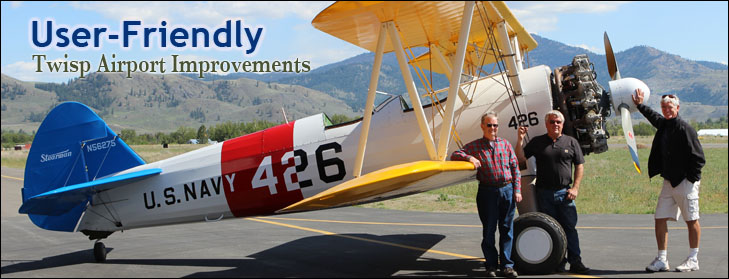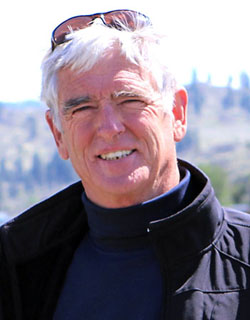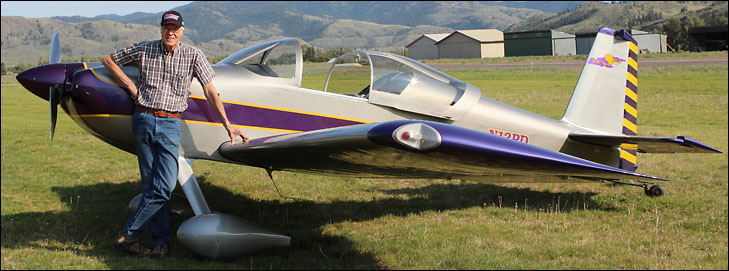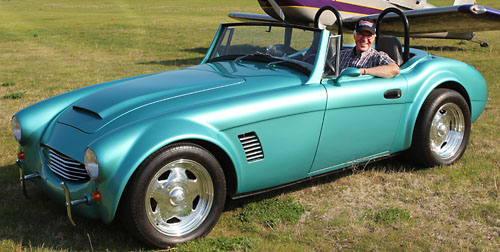|
 Kenmore Air Harbor mechanic Gordon Holbrook, left, with local pilots Mike Port and Morgan Smith by Port's restored Boeing Stearman World War II pilot training aircraft. Kenmore Air Harbor mechanic Gordon Holbrook, left, with local pilots Mike Port and Morgan Smith by Port's restored Boeing Stearman World War II pilot training aircraft.
story and photos
by Solveig Torvik
 Local pilot Morgan Smith, member of the Twisp Muncipal Airport Advisory Board, believes a user-friendly airport is an economic benefit.
Pilots and passengers at the Twisp Municipal Airport can’t get a drink of water there, nor can they find a flushing toilet or a sink to wash their hands. There’s not even an office.
Plans are afoot to remedy all this. But they depend on whether the water in an old well at the site can be certified as safe to drink, according to town officials.
Results of the first test conducted recently by town public works superintendent Howard Moss were not satisfactory, he told Grist. The well did not pass inspection because of coliform bacteria in the water, which may indicate that it’s contaminated with dangerous pathogens.
That’s not unusual in old wells, Moss added. He will recommend that the Twisp Airport Improvement Club, the local pilots’ organization, disinfect it and run the well for four to five hours before he returns to re-test it, he said. His initial test was conducted after the water had run for 45 minutes, he explained.
A public hearing on the proposed airport improvements was held at Twisp town hall on May 22.
Even though the airport belongs to the town of Twisp, the old well in question does not, according to Moss, who added that he has not been able to find any documentation for the well, which is located between two hangars.
Moreover, taxpayers will not pay for the proposed infrastructure improvements, according to Mayor Soo Ing-Moody. It will be up to the owners of the 32 hangars at the airport to figure out how to make them happen if the well proves safe, she told Grist.
It won’t be the first time the pilots make improvements to the town’s airport. Since the airport’s inception in 1944, the Twisp Airport Improvement Club periodically has donated labor or funds to upgrade the facility, according to board member Morgan Smith.
In the 1970s, pilots got a coarse runway surface laid at no cost to the town on what had been dirt runway, for example, and one of its members provided a granite sign on the highway directing people to the airport. When the Washington State Department of Transportation’s Aviation Division provided a $50,000 grant for an improved paved road from Highway 20 to the airport, the pilots provided the required 5 per cent matching funds, some of it “in- kind” labor. And the same thing happened last year when an $800,000 state DOT grant was awarded to build the upgraded 2,800-foot paved runway using aviation fuel tax funds. The town, which owns the land the airport sits on, did not provide the five per cent matching funds/in-kind labor required for that grant; the pilots did, according to Smith.
 Don Owens, another advisory board member, with the two-passenger RV-7 aluminum aircraft he built. It can fly up to 200 miles per hour, burning 10 gallons of fuel per hour. Don Owens, another advisory board member, with the two-passenger RV-7 aluminum aircraft he built. It can fly up to 200 miles per hour, burning 10 gallons of fuel per hour.
The pilots who have built hangars on the airport’s 50-by-50-foot lots lease the land on which their buildings sit from the town for a modest $185.40 a year. To critics who say the lease rate should be higher, the pilots say it’s a fair trade for improvements they donate to the town’s facility.
“If the airport is user-friendly, as this one is, it’s an economic benefit to the town,” said Smith, a former Delta Airlines pilot who moved here from Utah in 2002. The aim of the pilot’s group is “not to be a burden to the city,” he added. The club even pays the expense of keeping a courtesy car - donated by Larry Therriault - available for visitors to drive when they fly in and need transportation to town. Improvement club officials estimate that several hundred visiting aircraft land at the airport each year, though no actual count or record of the visiting aircraft traffic is kept.
The town does provide plowing service that keeps the access road to the airport and its runway clear in winter. It also provides some administrative support such as billing, as well as liability insurance for the facility, according to town treasurer Jackie Moriarity.
The town’s operating budget for the airport is $5,590 this year, Moriarity said, with slightly more revenues than expenses. “Usually it’s a wash,” she said of the income and expenditure for the airport. The ground leases for the 32 hangar lots cover the town’s airport operating expenses, she said. Air ambulances use the airport, as does the commercial passenger Catlin Flying Service, which pays the same rate as the non-commercial private pilots, she added.
 Don Owens also built this kit car, which resembles an Austin Healy but has a Chevrolet engine and a Ford rear end.
There is no paid town employee working at the airport. Airport manager Bob Howson donates his time. Among his responsibilities are assuring that the runway lights are working and notifying aviation authorities if the airport is closed.
The roughly 25-acre airport lies just south of town but outside its boundaries in an annexed island that also includes a ball field. It has landing lights that can be turned on at night by pilots using their radio. “There’s no regulation that prevents anyone from landing there at night,” said Smith. But, he added, due to the challenging local terrain, “There’s not much night flying that’s done around here.”
Ing-Moody said that in the interest of accountability to the public, she’s asked the three members of the pilots’ club board, Smith, Don Owens and Mike Port, to act as the Twisp Airport Advisory Board and hold publicly advertised monthly meetings at town hall to conduct airport business. They serve as the airport’s liaison with the town, she said.
On June 8 and 9, the pilots will host their annual Fly-In Weekend, with a barbecue at the airport Friday night. A pancake breakfast starts at 7 a. m. and runs to 11 a.m. on Saturday. Local residents are invited to come for the $7 breakfast and to visit during the airport’s open house Saturday, when lovingly built or restored aircraft will be on display.
Among them is a gleaming aluminum two-passenger homebuilt kit craft, an RV-7, owned by Owens, a former pilot for United Airlines, and a two-passenger 1942 bi-wing Boeing Stearman aircraft used to train World War II U.S. Navy fighter pilots. The Stearmans often were converted to crop dusters after the war, and this one was used for agricultural spraying in the Methow Valley, said proud owner Mike Port, who added: “I restored it to its original condition.”
|
